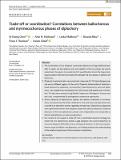Por favor, use este identificador para citar o enlazar a este item:
http://hdl.handle.net/10261/247829COMPARTIR / EXPORTAR:
 SHARE SHARE
 CORE
BASE CORE
BASE
|
|
| Visualizar otros formatos: MARC | Dublin Core | RDF | ORE | MODS | METS | DIDL | DATACITE | |

| Título: | Trade-off or coordination? Correlations between ballochorous and myrmecochorous phases of diplochory |
Autor: | Chen, Si‐Chong; Pahlevani, Amir H.; Malíková, Lenka; Riina, Ricarda CSIC ORCID; Thomson, Fiona J.; Giladi, Itamar | Palabras clave: | Dispersal distance dispersal investment Euphorbia Mercurialis annua Seed dispersal seed mass |
Fecha de publicación: | 2019 | Editor: | Blackwell Publishing British Ecological Society |
Citación: | Functional Ecology (2019) | Resumen: | The combination of two dispersal syndromes (diplochory) brings additional benefits to seeds, yet the relative costs and benefits of the two phases are poorly understood. Our goal is to provide the first quantification to test the long-standing assumption that there are trade-offs between the two phases in ballistic–ant diplochory. Dispersal investment data were empirically measured for 91 Euphorbiaceae species across different regions of the world. Dispersal distance data of ballochory (seed dispersal by explosion), myrmecochory (seed dispersal by ants) and diplochory was collated from the literature for 210 records (148 species from 44 families). The data were analysed using Model II regression, Kolmogorov–Smirnov test and t test, complemented by phylogenetic comparative approaches. Across diaspores of diplochorous species, the relative investment in myrmecochory increased more than that in ballochory. Fruit coat mass and elaiosome mass covaried in an allometric manner, regardless of seed mass. Diplochorous diaspores were significantly heavier than diaspores dispersed solely by ballochory. Dispersal distances of the two diplochorous phases were independent and comparable to that of sole ballochory or sole myrmecochory. Our results do not support a trade-off, but a coordinated dispersal strategy between the two diplochorous phases. Large diaspores may evolve diplochory to overcome dispersal difficulties in term of dispersal distance. As the most comprehensive study of ballistic–ant diplochory, our findings advance the understanding of the relative importance of the two phases in diplochory. A plain language summary is available for this article. | Versión del editor: | http://dx.doi.org/10.1111/1365-2435.13353 | URI: | http://hdl.handle.net/10261/247829 | DOI: | 10.1111/1365-2435.13353 | Identificadores: | doi: 10.1111/1365-2435.13353 issn: 1365-2435 |
| Aparece en las colecciones: | (RJB) Artículos |
Ficheros en este ítem:
| Fichero | Descripción | Tamaño | Formato | |
|---|---|---|---|---|
| 1365-2435.13353.pdf | 1,27 MB | Adobe PDF |  Visualizar/Abrir |
CORE Recommender
SCOPUSTM
Citations
15
checked on 23-may-2024
WEB OF SCIENCETM
Citations
14
checked on 29-feb-2024
Page view(s)
51
checked on 27-may-2024
Download(s)
155
checked on 27-may-2024
Google ScholarTM
Check
Altmetric
Altmetric
NOTA: Los ítems de Digital.CSIC están protegidos por copyright, con todos los derechos reservados, a menos que se indique lo contrario.
